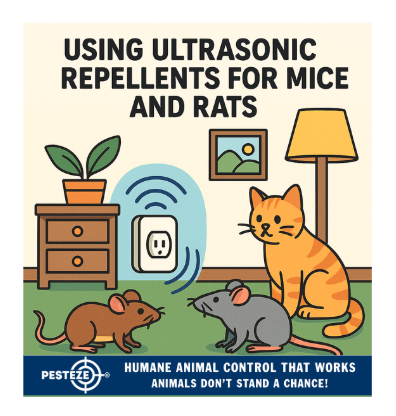USING ULTRASONIC REPELLENTS FOR MICE AND RATS

USING ULTRASONIC REPELLENTS FOR MICE AND RATS
SUMMARY
Ultrasonic repellents emit high-frequency sound meant to make indoor spaces uncomfortable for rodents. This guide explains how they work, realistic expectations, placement and safety tips, and how to combine them with exclusion and sanitation for best results.
FEATURES
-
How They Work: High-frequency pulses intended to annoy rodents and disrupt nesting.
-
Effectiveness Caveat: Results are mixed—habituation is common and structural factors matter.
-
Placement Tips: Where to put units for best coverage and to avoid sound-blocking obstacles.
-
Pet & Human Safety: Consider impacts on pets (rodent pets, some wildlife) and household members.
-
Complementary Measures: Use alongside sealing entry points, traps, and sanitation.
-
Troubleshooting: What to change if devices seem ineffective.
GUIDE DESCRIPTION
Ultrasonic rodent repellents create sound at frequencies above human hearing (typically 20–60 kHz). The idea is simple: high-frequency noise stresses rodents, interferes with their communication, and makes an area less hospitable. They appeal because they’re non-lethal, plug-in units are inexpensive, and installation is easy. But practical performance varies a lot depending on the product, room layout, and the species involved.
Realistic expectations matter. Scientific tests and field reports show mixed outcomes. In some enclosed, simple spaces (a single small room or garage) a well-placed unit may reduce activity temporarily. In larger, cluttered, or multiroom homes, sound is blocked by walls, furniture, and insulation; rodents can avoid the noisy zones or habituate—learning to tolerate or ignore the noise. Ultrasonics rarely eliminate an established infestation by themselves and shouldn’t replace exclusion or sanitation.
Placement and setup: plug units into unobstructed outlets at about 3–6 feet height, pointing into the open area you want to protect. Avoid placing them behind furniture, inside cupboards, or near heavy drapery that absorbs sound. For best coverage, use multiple units in adjacent rooms rather than relying on a single device. Follow manufacturer specs for room-size coverage and power. Remember: ultrasonic waves do not pass through solid walls well, so assume each room is its own zone.
Safety and non-target animals: ultrasonics are inaudible to most people but can affect pets that hear higher frequencies—especially rodents kept as pets (hamsters, gerbils, mice), some small birds, and possibly dogs or cats that respond to high-pitched noises. If you have household rodent pets, don’t use these devices in the same rooms. Ultrasonics will not harm humans or most larger pets but watch for signs of stress in animals and discontinue if observed. They also have negligible effect on wild predators (owls, foxes) that could otherwise help control rodent populations.
Best practice is to use ultrasonic repellents as part of an integrated strategy: immediately seal entry points, remove attractants (food, water, nesting material), set appropriately placed traps or bait stations if needed, and maintain cleanliness. Use repellents to discourage re-settling after other control steps, not as the only tool. If activity persists, call a licensed pest professional—especially if you suspect disease risk, structural damage, or if pets/children could be exposed to baits or traps.
In short: ultrasonic repellents can be a low-cost supplement in some contexts, but they’re rarely a standalone fix. Combine them with exclusion, sanitation, monitoring, and targeted control for reliable, long-term rodent management.
- Saneeth Thota


Comments 0